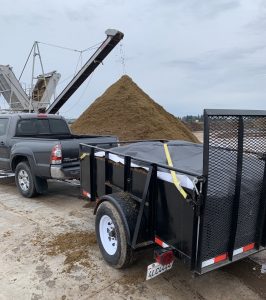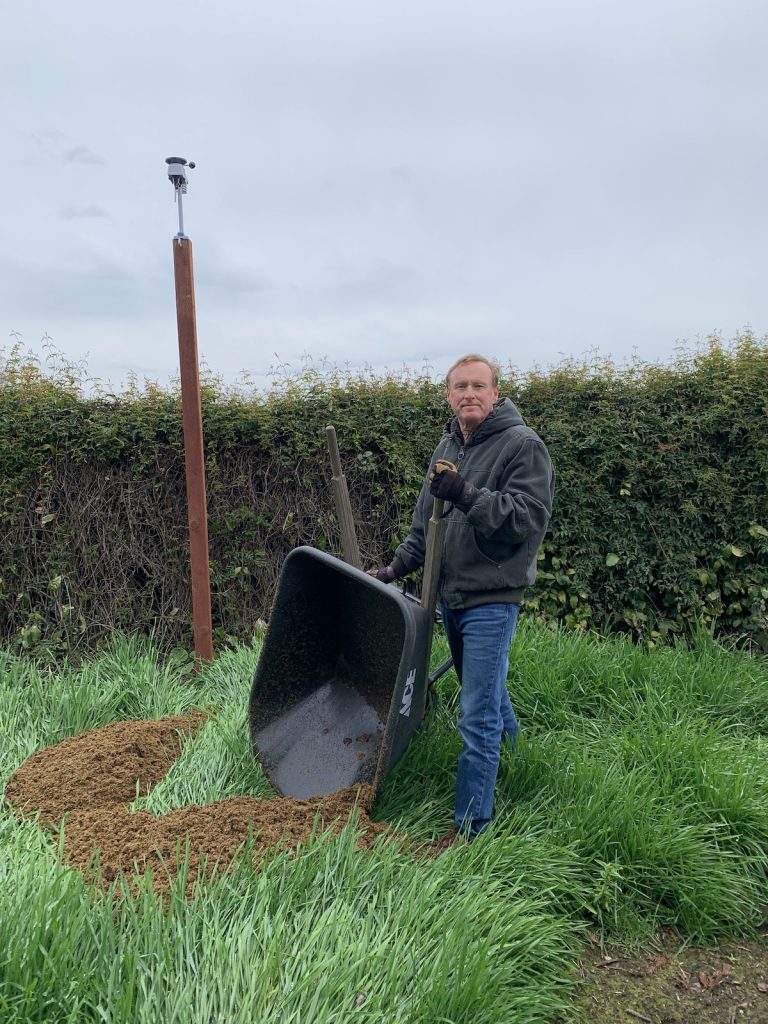Cow manure compost (or cattle) is a valuable and versatile organic amendment that holds a prominent place in sustainable gardening practices. This nutrient-rich soil additive is derived from the decomposition of cattle manure or “dung”, offering numerous benefits for soil fertility, plant growth, and environmental sustainability. In this blog, I will delve into the composition of manure compost, the process of creating it, its advantages, potential challenges, and the best practices for its application. My focus is the giant pumpkin patch; however, cattle manure can be a nutrient-rich addition for all vegetable gardening endeavors.

How does one find cattle manure? They have bags of manure at hardware stores such as Home Depot or Lowe’s. They are inexpensive and offer a few advantages. First, they can be purchased in low quantities and transported in the trunks of cars or backs of pick up trucks easily. It is even possible to put them inside the car; however, they are often dirty and will make a mess so be prepared.
Another reason I like to purchase bags of manure is that they are easy to transport and don’t make as much of a mess. You can move them to the garden without too much of a mess. They can lay on the ground and be opened up with you are ready to add the manure. The last reason I like manure in bags is that it is usually composted and ready to go. You don’t have to create compost it before using.
If you have access to a pickup truck and or a trailer and you are close to dairies, it is typically easy to get a free load of fresh manure. This is definitely the most economical way, but it is definitely the messiest!
What is in Cow Manure?
Cattle manure is a rich source of organic matter, nitrogen, phosphorus, and potassium, along with various micronutrients essential for plant growth. The composition of cattle manure can vary depending on factors such as the cow’s diet, age, and overall health, as well as the management practices on the farm. Generally, cattle manure contains approximately 1-2% nitrogen, 0.5-0.3% phosphorus, and 1-2% potassium, making it a well-balanced fertilizer. When I get a free load of the smell stuff, I am too excited to ask about cow diets or anything like that. I am just happy.
When cattle manure undergoes the composting process, it undergoes a transformation that results in cattle manure compost. This compost not only retains the essential nutrients found in raw manure but also improves the overall quality of the soil through enhanced organic matter.
What to do with Raw Manure
The process of creating aged cow manure compost involves composting the raw manure to facilitate decomposition and the formation of a stable, nutrient-rich end product. First in the process is to collect fresh manure from dairy farms or cattle ranches. It is helpful to ensure that the manure is free from contaminants such as antibiotics or chemicals, as these can have detrimental effects on the composting process and soil health.
To create a balanced compost, carbon-rich materials, often referred to as “browns,” are added to the manure. Browns include materials such as straw, hay, or dry leaves. This helps achieve the right carbon-to-nitrogen ratio for optimal microbial activity. This is when you put your compost piles to work. In addition, nitrogen-rich materials, or “greens,” should be added to provide a balanced nutrient profile. Greens can include kitchen scraps, fresh plant material, or other nitrogen-rich organic waste.
Turning the compost regularly promotes aeration, ensuring that oxygen reaches the microbes responsible for decomposition. Proper moisture levels are also crucial; the compost should be damp but not waterlogged. Composting generates heat as a byproduct of microbial activity. Monitoring the internal temperature of the compost pile is essential, as it indicates the effectiveness of the composting process. The pile should reach and sustain temperatures between 120-160°F (49-71°C).
The composting process typically takes several weeks to a few months, depending on factors such as pile size, composition, and environmental conditions. During this maturation period, the compost undergoes a curing process that stabilizes the nutrients and ensures the elimination of pathogens.
Cattle compost is a nutrient-rich soil amendment, providing essential elements like nitrogen, phosphorus, and potassium. It improves soil fertility, supporting robust plant growth. The organic matter in cattle manure compost contributes to soil structure improvement. It enhances soil aggregation, drainage, and aeration, creating a favorable environment for plant roots. Cattle manure compost introduces beneficial microorganisms to the soil, including bacteria and fungi. These microbes play a vital role in nutrient cycling, promoting a healthy and balanced soil ecosystem.
The organic matter in cattle manure compost improves the soil’s water retention capacity. This is particularly beneficial in areas with irregular rainfall, helping plants access moisture during dry periods. Cattle manure compost has a neutralizing effect on soil pH. While fresh manure may be slightly acidic, the composting process tends to balance the pH, making it suitable for a wide range of crops. Reduced Environmental Impact: By composting cattle manure, farmers contribute to reducing the environmental impact associated with raw manure application. Composting minimizes odor, eliminates pathogens, and prevents nutrient runoff, promoting responsible agriculture.
Be Careful
Raw manure may contain pathogens that can pose risks to human health. Proper composting, reaching temperatures sufficient to kill pathogens, is essential to mitigate this risk. Raw manure can have a strong and unpleasant odor. While composting significantly reduces odor, proper management practices and site selection are crucial to minimize any potential nuisances.
Careful consideration must be given to nutrient management to avoid over-application of nutrients. Excessive application can lead to nutrient runoff, negatively impacting water bodies and ecosystems. Successful cattle manure composting requires suitable infrastructure, including space, equipment, and proper turning mechanisms. Small-scale farmers or gardeners may need to adapt composting methods to suit their available resources. In terms of growing giant pumpkins, I seldom overdue it with compost.
Apply manure compost at the beginning of the growing season or during soil preparation. This allows the compost to integrate into the soil and provide nutrients gradually as plants require them.Ensure an even distribution of cattle manure compost across the planting area. This helps avoid localized nutrient imbalances and ensures consistent plant growth. Incorporate the compost into the soil by tilling or mixing to facilitate better nutrient availability for plants. This also helps enhance soil structure.
Regularly monitor soil nutrient levels to avoid over-application of nutrients. Soil testing provides valuable insights into nutrient content, allowing for informed decision-making.Practice crop rotation to prevent the buildup of specific nutrients in the soil. This helps maintain a balanced nutrient profile and reduces the risk of nutrient imbalances.
Conclusion
Cattle manure compost stands as a testament to the transformative power of composting in agriculture and gardening. From a raw byproduct laden with nutrients, cattle manure compost emerges as a stable, beneficial soil amendment that fosters sustainable and environmentally friendly practices.
As agriculture continues to evolve towards more sustainable and regenerative approaches, the use of cattle manure compost represents a responsible and effective way to enhance soil fertility, improve crop yields, and contribute to overall ecosystem health. By adhering to best practices in composting, application, and nutrient management, farmers and gardeners can harness the potential of cattle manure compost to cultivate healthy and resilient agricultural systems.
There are lots of external resources related to cattle manure composting. For those of you giant pumpkin growers among the group, be sure to see my book, Backyard Big: Growing Atlantic Giant Pumpkins in your Backyard. In addition, my book Backyard Big: Growing Food in Your Backyard includes a lot of information about composting. Both these books are available on Amazon and Barnes & Noble. Be sure to check out my Garden Blog for related topics as well.

